3.8.1 Purpose of protected shaft
E
Explanations & Illustrations
Clause 3.8.1 : Purpose of protected shaft
The purposes of providing protected shaft are to delay or prevent the spread of fire between compartments through which staircases or other shafts pass directly and to enable people or things or air to pass between compartments. The purpose of each shaft
are as follows:
a. The staircase shaft is a vertical shaft which enables the passage of
movements of people.
b. The service shaft enables the passage of cable, building service ducts/pipes.
c. The lift shaft enables the movements of lift cars.
“Protected Shafts” include staircase, lift shafts, chutes, ducts or any other shaft enabling movement of people, goods, air, pipes, etc..
Protecting structures shall be treated as elements of structure for the purpose of determining the period of fire resistance rating.
Construction of compartment walls and floors shall be constructed entirely of non-combustible material. However, there were exceptions specially allowed for under the conservation programme. The exemption was an understanding between the SCDF and URA.
As a general guide, QPs are required to seek prior consultation with the SCDF before making formal building plan submission.
Any structural members carrying compartment walls or floors must also comply with the requirement of non-combustibility. Apart from the contribution made by suspended ceilings under Cl.3.3.5, the fire resistance of the structural members must be attained without assistance from any combustible material (with the exception of buildings designated for conservation).
A protected shaft shall not be used for any purpose additional to those given as defined under Cl.1.4.85. All services such as,
pipe/duct installation shall not be located inside a protected staircase,unless otherwise permitted in Cl.3.8.7. Likewise, no washroom is allowed to be located inside an exit staircase.
Effective Date: 15 Sep 2020
Amendment History
| 3.8.1 |
15 Sep 2020 |
15 Sep 2020 |
Revised |
Purpose of protected shaft A protected shaft shall not be used for any purpose additional to those given as defined under Cl.1.4.82. All services such as, pipe/duct installation shall not be located inside a protected staircase. Likewise, no washroom is allowed to be located inside protected staircase. |
15 Sep 2020 |
Download
|
3.8.2 Requirements of protected shaft
E
Explanations & Illustrations
Clause 3.8.2 : Requirements of protected shaft
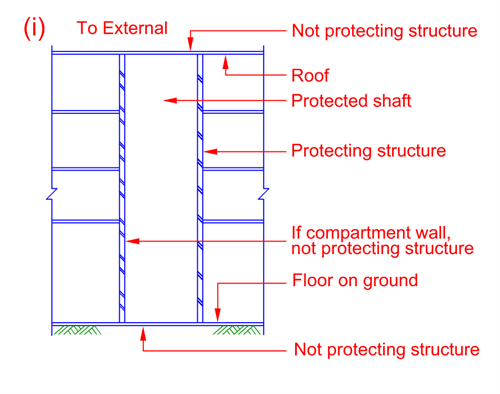
Figure 3.8.2 - 1
Protected shafts penetrate across compartments or floors in a building. They can be shafts carrying utilities (piping, electrical and telecommunication cables etc.) or service shafts carrying lifts and exit staircases. The enclosing walls and floors to
the protected shaft shall be constructed of non-combustible materials, including any beam or column, which forms part of the enclosure.
In the above figure, a protected shaft is enclosed at the top by roof slab, the sides by fire-rated walls and the bottom by the ground floor slab. The protecting structures to the shaft would exclude the roof slab, which is exposed to the external, the
ground floor slab, which is in contact with the ground and any compartment wall, which separates one compartment from another.
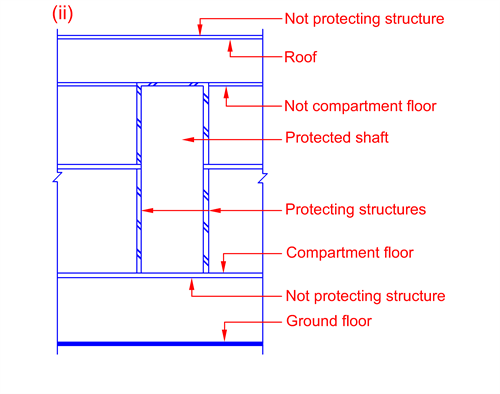
Figure 3.8.2 - 2
Protected shaft is enclosed by internal walls, ceiling and floor. Protecting structures will include the walls and slab above; and the floor at the base of shaft is excluded, because it is a compartment floor.
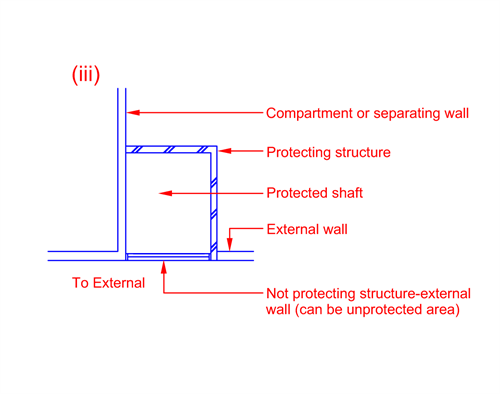
Figure 3.8.2 - 3
Protected shaft is located against an external wall. The protecting structures will include internal walls, which are not compartment or separating wall.
Where the protection afforded to a compartment is penetrated to allow the movement of people, goods or anything else between compartments by means of e.g. a staircase, lift or duct, the protection to the compartment must not be lowered or diminished.
This is achieved by enclosing the means of transportation from one compartment to another in a protected shaft which is so constructed that any penetration of the enclosures to the shaft poses no direct or indirect threat to the compartments connected
by the shaft. Hence, the term “protected shaft” and “protecting structure” for the structure enclosing such a shaft. The elements enclosing the shaft (unless formed by adjacent external walls) are compartment walls and floors.
The above figure illustrates a shaft, which is enclosed by compartment or separating wall, external wall and internal walls called protecting structure. The fire resistance of the compartment or separating wall should be based on the size of the floor
area or cubical extent of the adjoining larger compartment and shall not be less than 1 hour.
The fire resistance of the external wall would be determined by the separation distance requirements under Cl.3.5. The external
wall is not a protecting structure and could be fully unprotected areas having no fire resistance. The remaining 2 walls of the shaft are protecting structure which must be imperforate except for certain permitted openings, e.g. inspection doors which
need to have fire resistance equivalent to half that of the protecting structure. All protecting structure shall be constructed of non-combustible material except for surface linings, which shall comply with
Cl.3.13. The fire resistance of the protecting structures shall be that for the elements of structure of the building.
Protecting structures exclude external wall. External walls need not have fire resistance rating, subject to complying with Cl.3.5 to be unprotected areas.
Every protected shaft shall be required to:
a. form a complete barrier to fire between the different compartments which the shaft connects;
b. have the appropriate fire resistance to comply with the requirements of Cl.3.3; and
c. be constructed of non-combustible material (together with any beam or column which forms part of the enclosure and any structure which carries it).
3.8.3 Openings in protected shaft
a. A protected shaft shall have no openings in its enclosure, except in the case of any part of the enclosure:
(1) which is formed by a separating wall, any opening which complies with the requirements of Cl.3.6 for separating walls, or
(2) which is formed by a compartment wall or a compartment floor, any opening which complies with the requirements of Cl.3.7 for compartment wall or compartment floor, or
E
Explanations & Illustrations
Clause 3.8.3a.(1) : Openings in protected shaft
.tmb-firecode.png?Culture=en&sfvrsn=716aba9e_1)
Figure 3.8.3a.(1)
Protected shaft bounded on three sides by protecting structure and fourth side by an external wall. Permitted opening to each unit shall be protected by a door of at least one half of the fire resistance rating of the enclosing wall, or half an hour, whichever is the greater. The aggregate fire resistance of the 2 doors shall not be less than the fire resistance of the protecting structure.
(3) which is formed by the protecting structure:
(a) a door which has the appropriate fire resistance to comply with the requirements of Cl.3.4 for test of fire resistance, or otherwise
permitted by provision of Cl.3.8.6, or
(b) the passage of a pipe, excluding protecting structure to exit staircase and exit passageway, or
(c) inlets to and outlets from and opening for the duct, if the shaft contains or serves as a ventilation duct.
b. Such openings in the protected shaft shall be protected to comply with the relevant provisions of Cl.3.9 for protection of
openings.
E
Explanations & Illustrations
Clause 3.8.3a.(3) : Openings in protected shaft
-1.tmb-firecode.png?Culture=en&sfvrsn=9551f78_1)
Figure 3.8.3a.(3) - 1
-2.tmb-firecode.png?Culture=en&sfvrsn=18cde179_1)
Figure 3.8.3a.(3) - 2
-2.tmb-firecode.png?Culture=en&sfvrsn=18cde179_1)
Figure 3.8.3a.(3) - 3
Fire resisting doors to comply with Cl.3.9.2 and shall have ½-hr fire resistance or half the resistance of the enclosing walls,
whichever is the greater:
a. Any opening in compartment floor/wall would constitute a break in compartmentation. Therefore even small service pipes, strictly speaking must be enclosed in protected shaft.
b. However, Cl.3.9 allows pipe size not greater than those sizes provided in Table 3.9A to be unprotected, provided the pipes are to be spaced at min. 50mm apart or half the diameter of the larger pipe, whichever is larger. This is to avoid clustering
of pipes which would weaken the compartment floor or wall
c. Openings in compartment floors to accommodate staircases, lifts and services form a vertical shaft which can become a ready means of passage of fire from one storey to another, accentuated by the flue effect created by a fire.
d. Hence, protected shafts are needed to maintain the overall fire integrity of the building. However, these shafts need to have door openings for movement of people, e.g. staircase, lifts and maintenance purposes in the case of shafts containing
services. All the door openings to protected shaft are considered the sources of weakness in the integrity of the shafts and they must be protected.
e. Door openings
Doors in protected shaft must have at least ½-hr fire resistance rating or half the fire resistance of the protecting structure whichever is greater.
Such a relaxation from the full standard of fire integrity is reasonable as it is expected that combustible materials would not be placed next to the door and that a fire has to break into the shaft and break out again at the upper level. Also if the
top of the shaft is adequately ventilated, the tendency for lateral spread is considerably reduced.
f. The primary purpose of protecting structure is to provide the compartmentation between floors. As such the structure shall have full fire resistance as the elements of structure. The relaxation on fire resistance accorded to fire doors shall not be
extended to the protecting structure i.e. halve the fire resistance of the elements of structure. The main reason is that by halving the fire resistance of protecting structure, the threat of failure and collapse of the enclosing walls would be greater
in times of fire emergency and should the walls collapse, large opening would be created in the shaft to permit the spread of fire and smoke, which is not acceptable. As to door openings in protected shaft, the eventual failure of the fire door is
considered acceptable owing to the limited door opening size. See illustrations (c) and (d) [Figure 3.8.3a.(3) - 3].
g. Ventilation ducts
Ventilation ducts are usually constructed of sheet metal, which do not have fire resistance and therefore should a fire occur, they will quickly distort and collapse leaving a hole in any wall through which they pass. Conversely, a fire occurring in the
duct could also cause collapse.
Therefore, where the duct penetrates the protected shaft, a fire damper should be fitted at the opening of the protecting structure. The fire damper shall be capable of sealing the opening in the protecting structure and be installed independently of
the duct trunking. In this way, the fire damper would not be affected by collapse of duct work and be able to maintain the fire integrity of the shaft. See illustration (a) [Figure 3.8.3a.(3) - 1].
h. Pipes
Where pipes are contained within a protected shaft, the problem of maintaining the integrity of the fire compartment is made simple, irrespective whether the pipes are made of UPVC or combustible materials. However, for gas pipes or pipes containing combustible
liquids, they shall be located in separate shafts.
i. The construction of gas pipes shaft is different from other shafts owing to the need to provide through or external ventilation. Gas pipe shaft shall comply fully with SS CP 51. See illustration (b) [Figure 3.8.3a.(3) - 2].
j. General
In order to maintain the level of integrity of protected shafts, openings in protected shafts shall be restricted to the following:
(1) Openings for pipe
(2) Door openings to lift shaft, staircase
(3) Openings for ventilation ducts
(4) Access openings for electrical cables shaft
(5) Openings for chutes, linen or refuse
3.8.4 Non-combustibility of protecting structures
E
Explanations & Illustrations
Clause 3.8.4 : Non-combustibility of protecting structures
( No illustration )
The requirement that all protecting structure shall be constructed of non-combustible materials is also spelled out under Cl.3.8.2.
As to the provision of combustible finishes to floor, wall and ceiling, it must be observed that such provision will not be permitted inside protected shafts that are used for the passage of people such as exit staircases and exit passageways under
Cl.3.10.4 and Cl.3.13.6.
Every protecting structure shall be constructed wholly of non-combustible materials except that floor, wall and ceiling finishes which do not contribute to the fire resistance of such protecting structure are not be required to comply with the requirements for non-combustibility.
3.8.5 Ventilation of protected shaft
E
Explanations & Illustrations
Clause 3.8.5 : Ventilation of protected shaft
( No illustration )
Protected shaft used for passage of people, such as exit staircases shall be provided with adequate natural ventilation by fixed openings in the external walls. Such openings shall have an area of not less than 10 percent of the floor area per floor of
the staircase. Alternatively, the staircase can be mechanically ventilated under Cl.2.3.3d.(7). However, for internal exit staircase serving
more than 4 storeys, the supply air shall be mechanically conveyed via a vertical duct extending through the staircase height and discharging from outlets distributed at alternate floor. Where the internal exit staircase exceeds 24m in height without
provision for natural ventilation, the staircase shall be pressurised in accordance with Cl.2.3.3d.(8).
The mechanical ventilation system to internal staircase serving more than 4 storey and the pressurisation system to internal exit staircase exceeding 24m shall be connected to emergency power supply. In addition, a remote manual start-stop switch shall
be make available to firefighters at the fire command centre, or at the fire indicating board where there is no FCC. The start-stop switch provides the firefighter a quick means to shut-off the fans should it be detected that smoke had been drawn
into the staircase by the fresh air supply fan.
A protected shaft conveying piped flammable gas should be adequately ventilated directly to the outside air by ventilation openings at high and low level in the shaft or comply with the modes of ventilation allowed in SS 608. All gas pipe installations
shall be vetted and approved by acceptable organisation (e.g. Powergas) before any works can be carried out on site.
Ventilation of protected shaft shall comply with the following:
a. A protected shaft used for the passage of people, such as exit staircases, shall be ventilated to comply with the relevant provisions of the Code.
b. A protected shaft containing a pipe conveying gas shall be adequately ventilated directly to the outside air or have other modes of ventilation allowed under SS 608.
3.8.6 Doors in protecting structures
E
Explanations & Illustrations
Clause 3.8.6 : Doors in protecting structures
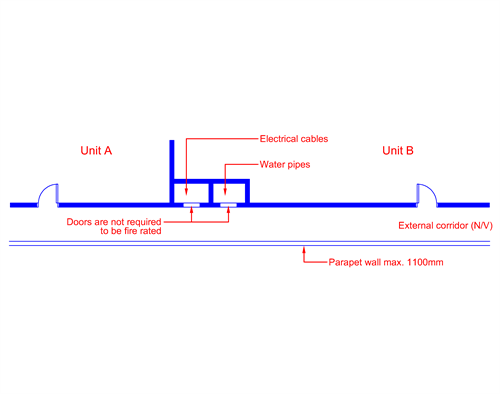
Figure 3.8.6 - 1
As the doors in the electrical and pipe shafts are opening into an external corridor which is naturally ventilated, there is no need to fire rate the doors.
Protected shaft A serves 2 compartments. Compartment A could be a common area e.g. lounge and compartment B in factory/warehouse unit.
Door A1 is opening in the direction of exit travel, whereas door A2 is the entrance door of the factory/warehouse unit, which swings inward. The number of exit door openings in a protected shaft containing an exit staircase shall not exceed two per floor.
This is to prevent additional openings from weakening the integrity of the protecting structure.
The aggregate fire resistance of door A1 and A2 shall not be less than the compartment wall or the protecting structures to the shaft. This is to ensure that the fire resistance between compartment A and B is not reduced at the door openings.
Door A1 can be held in the open position provided it is fitted with electromagnetic or electromechanical device. See Cl.1.4.34.
All doors in shaft A & B shall have the fire resistance rating of half that of the enclosing protecting structures to the shafts, but shall never be less than half hour. See also Cl.3.8.3 for further explanation.
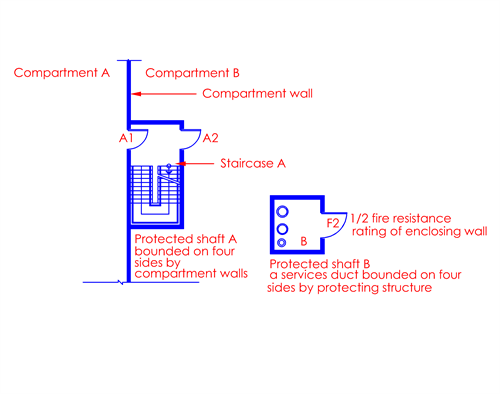
Figure 3.8.6 - 2
Protected shaft A serves 2 compartments. Compartment A could be a common area e.g. lounge and compartment B in an office unit.
All doors in shaft A & B shall have the fire resistance rating of half that of the enclosing protecting structures to the shafts, but shall never be less than half hour. See also Cl.3.8.3 for further explanation.
Door A1 is opening in the direction of exit travel, whereas door A2 is the entrance door of the health care occupancy unit, which swings inward. The number of exit door openings in a protected shaft containing an exit staircase shall not exceed two per
floor. This is to prevent additional openings from weakening the integrity of the protecting structure.
The aggregate fire resistance of door A1 and A2 shall not be less than that of the compartment wall or the protecting structures to the shaft. This is to ensure that the fire resistance between compartment A and B is not reduced at the door openings.
Door A1 can be held in the open position provided it is fitted with electromagnetic or electromechanical device. See Cl.1.4.34.
a. Any door fitted to an opening in protecting structure shall have fire resistance for not less than half the period required by other provisions of the Code for the protecting structure surrounding the opening.
b. Exception
(1) Any door fitted to an opening in protecting structure of a shaft containing services, such as electrical cables, pipes (including gas pipe in separate shaft), ducts etc., is not required to have the fire resistance rating if the door is located along the wall facing the external corridor.
(2) Any metal door fitted to an opening in protecting structure of a rubbish/ bin chute is not required to have the fire resistance rating if:
(a) the thickness of the rubbish/ bin chute door is at least 1.5mm;
(b) the rubbish/ bin chute door is sealed with rubber gasket; and
(c) the rubbish/ bin chute door shall be self-closing type.
c. Any door fitted to an opening in protecting structure of a shaft containing services, such as electrical and telecommunication cables, pipes (including gas pipe in separate shaft), ducts etc., is not required to comply with the requirements in Cl.2.3.9d.(2) if it is fitted with a self-closing device. Rising mains and hose reel doors shall not be fitted with self-closing device and shall comply with the stipulated corridor width when the door is in its fully opened position. Areas within the swing paths of the rising mains and hose reel doors shall be clear of any obstruction/ storage at all times.
Effective Date: 1 Sep 2021
Amendment History
| 3.8.6c. |
1 Mar 2021 |
1 Sep 2021 |
Revised/Clarification |
Nil |
1 Mar 2021 |
Download
|
3.8.7 Protected shaft containing exit staircase
a. A protected shaft which contains an exit staircase shall not contain any services e.g. pipes, cables, ducts, etc., that are not solely serving the same exit staircase (even if the services are protected with fire-rated dry construction), except for:
(1) cut-off sprinkler and pipe for that staircase;
(2) UPVC or cast iron rain water downpipes serving the roof directly above the exit staircase, and not routed through anywhere outside the staircase;
(3) rising mains; and
(4) metal water supply pipe and water tap not exceeding 50mm in diameter.
Effective Date: 15 Mar 2021
E
Explanations & Illustrations
Clause 3.8.7a. : Protected shaft containing exit staircase
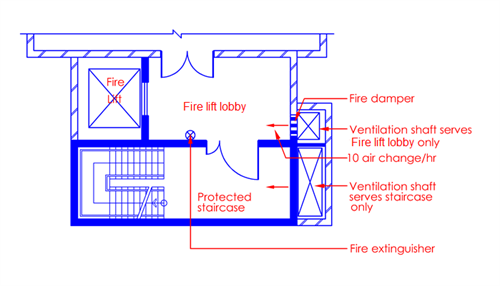
Figure 3.8.7a.
A fire lift and fire lift lobby in a building, which exceeds 24m in habitable height, have to be complemented by an exit staircase adjacent to them. Separate ventilation shafts are required to be provided for the staircase and fire lift lobby as depicted
in Cl.7.1.10.
Exit staircases serving any building irrespective of the height, shall be devoid of combustible wall, floor and ceiling finishes. Building services which are not solely serving the exit staircase shall not be allowed to be routed through or inside the
staircase. This is to prevent any possibilities of a fire occurring inside the staircase and the spread of fire into the staircase via the services such as electrical cables, ducts, combustible pipes, etc.. Cl.6.2.2 of the Fire Code allows vertical stack of rising main and landing valve to be located inside the staircase as a last resort where smoke-stop lobby and common area outside the staircase are not available. SS CP
10 allows sub-alarm panels to be located in the exit staircase provided there is no fire lift lobby or smoke-stop lobby in the building. The fire alarm cables shall be in metal conduit or trunking. This relaxation shall not apply to buildings which
are more than 4 storeys in height where provision of smoke-stop lobby is a requirement.
The exit staircases are the means of escape in fire emergencies. All occupants must use the staircases to evacuate safely from any storey level to the final exits at ground level. The time taken to descend a staircase in a high-rise buildings could be
more than an hour. With the staircase fully packed with evacuating occupants during an emergency, the staircase must be maintained safe from smoke, heat and fire throughout the fire resistance period of the enclosing protecting structures to the staircase.
An exception is allowed under Cl.3.8.9d. for maximum 4 storey residential building.
Amendment History
| 3.8.7 |
15 Mar 2021 |
15 Mar 2021 |
Revised |
Protected shaft containing exit staircase a. A protected shaft which contains an exit staircase shall not contain any services e.g. pipes, cables, ducts, etc., that are not solely serving the same exit staircase (even if the services are protected with fire-rated dry construction), except for: (1) cut-off sprinkler and pipe for that staircase; (2) UPVC or cast iron rain water downpipes serving the roof directly above the exit staircase, and not routed through anywhere outside the staircase; and (3) rising mains. |
15 Sep 2020 |
Download
|
b. The protecting structure shall be constructed of masonry, or drywall. If drywall construction is used, all of the following conditions shall be complied with:
(1) the drywall shall be non-combustible;
(2) the drywall shall have fire resistance rating for not less than the relevant period specified in Table 3.3A having regard to the purpose group of the building of which it forms a part and the dimension specified in that table;
(3) the drywall shall, in terms of impact & deflection performance, meet the partition grade specified under BS 9999 (Test for partitions) in accordance with BS 5234-2;
(4) the drywall shall meet the criteria, in terms of water absorption and bending strength performance, when subject to the test of BS EN 520 or ISO 1896; and
(5) the building shall have at least two independent exit staircase shafts (scissors exit staircases are considered single shaft).
E
Explanations & Illustrations
Clause 3.8.7b. : Protected shaft containing exit staircase
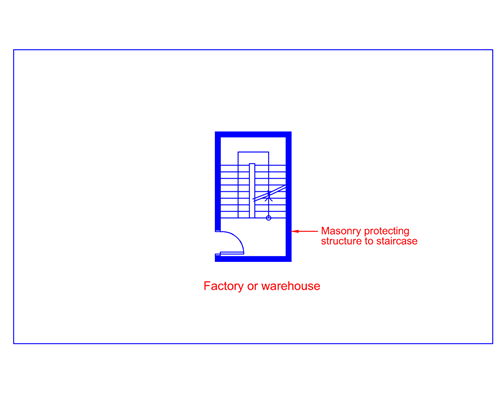
Figure 3.8.7b. - 1
Building designed with single exit staircase shall have the protecting structure constructed of masonry, which is more solid and stable than fire-rated dry walls. The main concern is that if the protecting structure, which is constructed of dry wall is damaged, smoke and heat would get into the staircase to affect the evacuees making their way down. Single exit staircase shall have its protected structure constructed of masonry.
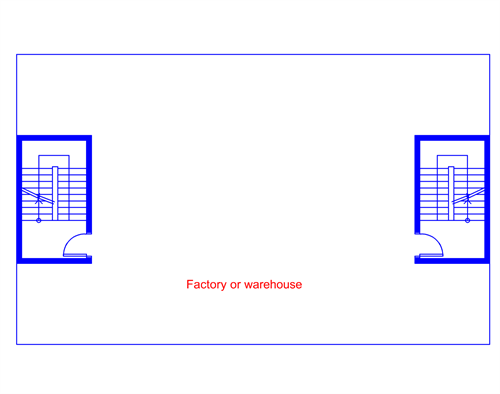
Figure 3.8.7b. - 2
Where two independent staircases are provided, the protecting structure to each of the staircase can be constructed of drywall.
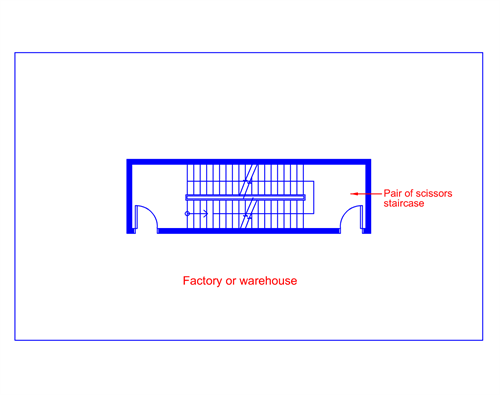
Figure 3.8.7b. - 3
Where a building is designed with a pair of scissors staircases to meet the provision of exit requirements, the scissors staircases shall be considered as within a common shaft if drywall is used for the construction of the protecting structure. The main reason is that if one of the shaft is damaged, the other shaft is likely to be affected, thereby causing smoke to get into both staircases. This would render the pair of scissors staircases inaccessible. In addition, the drywall enclosures are prone to other damages, thus affecting the effectiveness and integrity of the protected shafts. However, for the purpose of exit computation, the pair of scissors staircases shall literally be taken as 2 staircases though it could only qualify as a single shaft.
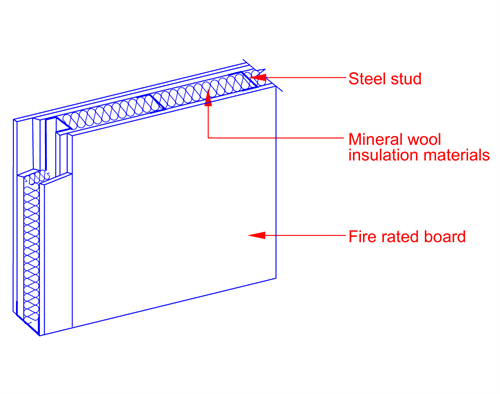
Figure 3.8.7b. - 4 : Drywall construction
Non-combustible steel studs, insulation materials and fire-rated boards shall be used for the construction of drywall.
A protected shaft which contains a lift shall comply with the following:
a. It shall not contain any pipe conveying gas or combustible liquid, other than those in the mechanism of a hydraulic lift.
b. The protecting structure shall be constructed of masonry, or drywall. If drywall construction is used, the conditions stipulated underCl.3.8.7b.(1) to (5) shall be complied with.
The drywall shall also meet the criteria of cyclic loading and dynamic test as specified under Cl.3.3 of the National Construction Code of Australia C 1.8.
E
Explanations & Illustrations
Clause 3.8.8a. : Lift shaft
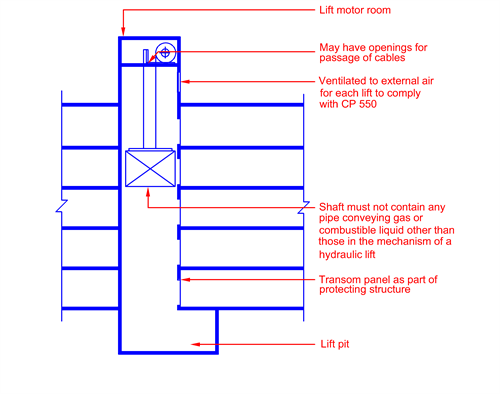
Section
Figure 3.8.8a. - 1 : Protected shaft for electrical lift
Lift shaft which is not located at the edge of atrium floors or at the external wall outside the building shall be constructed of masonry.
Cl.3.8.8a. specifically permits combustible liquid in the mechanism of hydraulic lift. The liquid is concealed in vessels and forms part of the mechanical system to permit the homing of the lift during an emergency. The liquid has a high flash point of over 400°C.
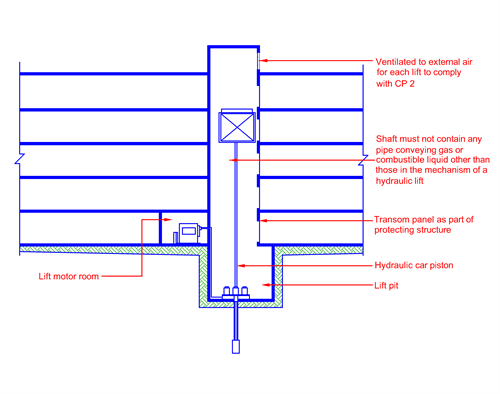
Section
Figure 3.8.8a. - 2 : Protected shaft for hydraulic lift
Lift shaft, which is not located at the edge of atrium floors or at the external wall outside the building, shall be constructed of masonry.
Cl.3.8.8a. specifically permits combustible liquid in the mechanism of hydraulic lift. The liquid is concealed in vessels and forms part of the mechanical system to permit the homing of the lift during an emergency. The liquid has a high flash point of over 400°C.
c. Where a lift is either located at the edge of atrium floors or at the external wall and outside the building, the lift shall be considered as not enclosed within a protected shaft.
E
Explanations & Illustrations
Clause 3.8.8c. : Lift shaft
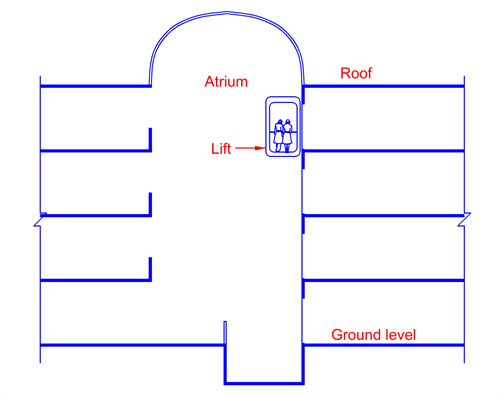
Section
Figure 3.8.8c. - 1
In the above figure the lift is unenclosed and being located within the atrium void. There is no penetration of any compartment floor and smoke migration caused by the ‘piston-effect’ of lift movement is no longer a concern. Smoke from a fire in any occupancy floor will flow from the ceiling layer into the atrium void where it will tend to rise upwards due to its natural buoyancy. A smoke control system would eventually extract the smoke out of the building.
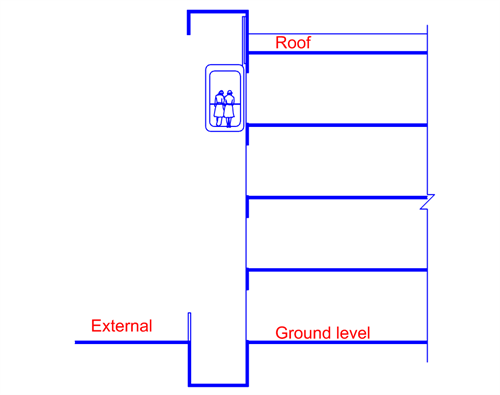
Section
Figure 3.8.8c. - 2
The lift is sited outside the external wall of the building. There is no concern of smoke and heat being transferred from floor to floor. Hence it is not required to be enclosed in a protected shaft. This type of lift is commonly known as ‘bubble lift’ or ‘sky lift’.
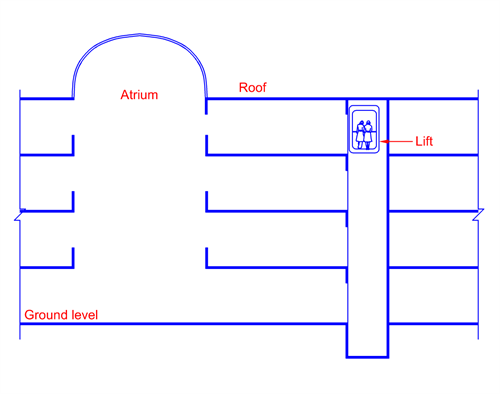
Section
Figure 3.8.8c. - 3
The above figure shows that the lift is located away from the atrium void. As the lift punctures through the compartment floors, it must be enclosed in a protected shaft to prevent the spread of smoke and heat from floor to floor.
d. The protected shaft shall be vented in accordance with SS 550. The vents shall be so arranged as to induce exhaust ventilation of the shaft. Where vents cannot be provided because of the location of the lift shaft, a ventilation duct protected by drywall
complying with Cl.3.8.7b. serving as ventilation of the shaft may be provided instead. If the duct is not fire-rated,
fire dampers shall be provided to the duct at the wall of the lift shaft, provided such relaxation shall not apply to shafts containing a fire lift.
e. Openings for the passage of lift cables into the lift motor room located above or at the bottom of the shaft shall be as small as practicable.
E
Explanations & Illustrations
Clause 3.8.8d. : Lift shaft
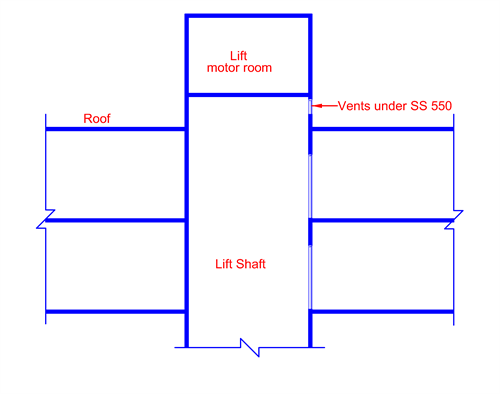
Figure 3.8.8d. - 1
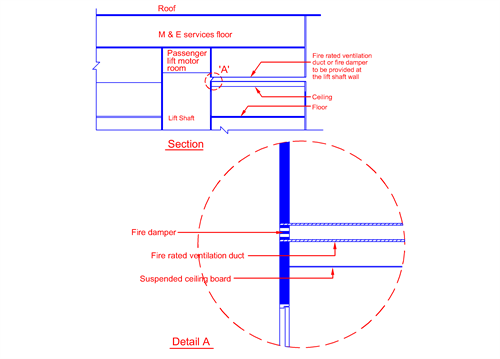
Figure 3.8.8d. - 2
All lift shafts shall be vented at the top in accordance with SS 550. In situations, where the lift shafts could not be brought above the roof as shown in Figure 3.8.8d. – 2, horizontal fire rated duct could be used to provide air relief to the lift shaft. If the duct is not fire rated, appropriate fire damper could be provided in the wall of the protected lift shaft as shown ‘A’ in the above diagram. The above relaxation shall not be applicable to fire lift.
f. Fire resistance
(1) A transom panel above the lift entrance shall be considered as part of the protecting structure and shall therefore conform to the fire resistance requirements of the protecting structure.
(2) In the case of motor-room-less lifts, the lift control panel enclosure located at the lift lobby shall not affect the fire resistance requirements of the protecting structure.
E
Explanations & Illustrations
Clause 3.8.8f. : Lift shaft
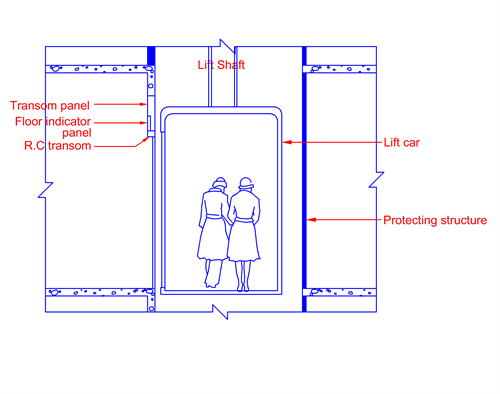
Section
Figure 3.8.8f.
Floor indicator panel should be surface mounted. If it is built into the transom panel, care should be taken to ensure that the fire resistance of the panel is not lowered. It is a common mistake to puncture the transom panel to receive the floor indicator
panel without giving consideration to the fire integrity of the panel. Such practice contravenes the above requirement, as Cl.3.8.2 requires that the protecting structure, including the transom panel, forms a complete barrier and should have the appropriate fire resistance rating.
g. If it serves any basement storey, it shall be enclosed by a protected lobby with walls having 1-hr fire resistance rating and fire door of ½-hr fire resistance rating. If the protected lobby also acts as a smoke-free lobby required under
Cl.2.2.13, it shall be mechanically ventilated in accordance with Cl.7.1.10.
Exception:
(1) Where the lift landing area is adjoining an air well or external space of minimum clear area 10m² and minimum width of 3m, the distance between the nearest edge of lift door opening to the air well shall not exceed 3m.
(2) Where the basement storey forms part of a building under PG I or a single household cluster housing compartment within a PG II development and has a basement area not exceeding 100m².
E
Explanations & Illustrations
Clause 3.8.8g. : Lift shaft
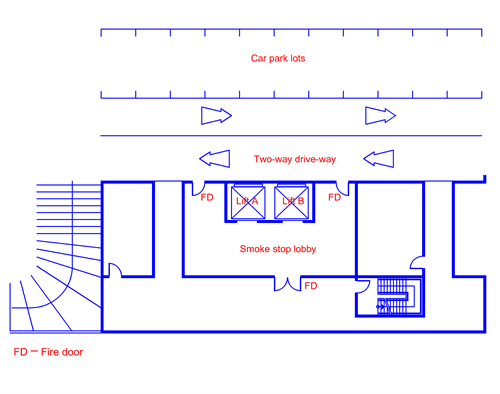
Figure 3.8.8g. - 1
Lift opening into basement and not adjoining a void that opens to the sky or any external spaces, shall be provided within a smoke-stop lobby having 1-hr fire-rated enclosures and ½-hr fire door.
The smoke-stop lobby acts as a buffer zone to prevent smoke from being drawn into the lift shaft through the ‘piston-effect’ of the movement of the lift.
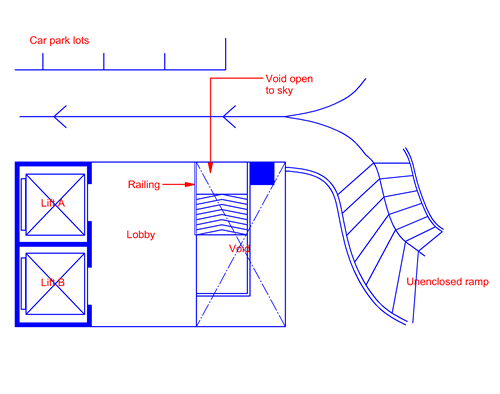
Figure 3.8.8g. - 2 : Basement floor plan
Lift opening into basement storey and adjoining a void opening to the sky or any external spaces does not require a smoke-stop lobby. Smoke occurring in the vicinity of the lift would be drawn into the void and vented upward into the open space. This provision would help to reduce the chance of smoke being sucked into the lift shaft.
h. Private lift
A private lift that is provided for the exclusive use of occupants in residential buildings under PG II shall comply with all of the following requirements:
(1) A smoke detector shall be provided at the lift landing area. The activation of any of the smoke detectors at the lift landing area shall cause the lift to home to the designated floor.
(2) Emergency power supply from a standby generating plant shall be provided to home the lift to the designated floor when there is a power failure in the building.
E
Explanations & Illustrations
Clause 3.8.8h. : Lift shaft
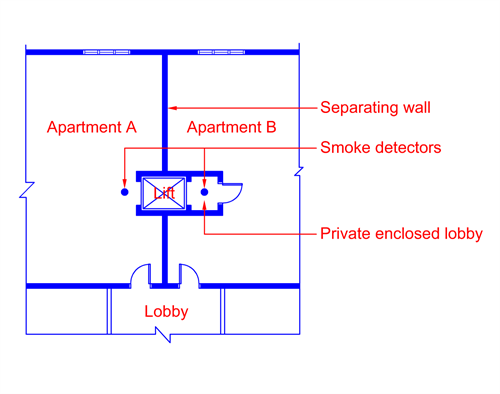
Figure 3.8.8h. - 1 : Private lift
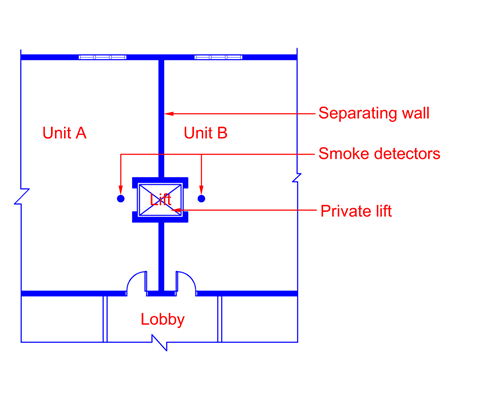
Figure 3.8.8h. - 2
(3) An alternate designated floor (e.g., any other floor with common lobby) shall be identified. The lift shall be brought to the alternate designated floor in the event that there is a fire at the 1st storey designated floor. For buildings without an alternate designated floor, the lift shall return to the last called floor in the event that the designated floor is on fire.
(4) The lift shall not serve as a fire lift.
(5) Private lifts shall comply with SS 550.
R
Rationale - Clause 3.8.8h.(3)
This requirement is to ensure that a private lift will not home to the designated floor if it is on fire. For residential buildings having private lifts and are unable to provide an alternate designated floor, the lift control has to be programmed to bring the passengers to a safe floor, normally the last called floor, for egress if the fire is on the designated floor.
3.8.9 Protected shaft containing other services installations
A protected shaft used for the enclosure of services shall comply with the following:
a. The protecting structure for a protected shaft, containing mechanical ventilation ducts serving areas specified in Cl.5.2.1g.(1) and Cl.5.2.1h. or kitchen exhaust ducts, which pass through floor slabs, shall be of masonry construction. Such a shaft
shall be completely compartmented from the rest of the shaft space containing other ducts or any other services installations. A protected shaft containing ducts serving other areas which pass through floor slabs can be constructed of drywall.
If the protected shaft is of drywall construction, the conditions stipulated in Cl.3.8.7b. shall be complied with.
E
Explanations & Illustrations
Clause 3.8.9a. : Protected shaft containing
other services/installations
The protecting structure for protected shaft containing kitchen exhaust duct and mechanical ventilation ducts which pass through one or more floors and serving areas such as:
a. Exit staircases and exit passageways
b. Smoke-stop and fire lift lobby
c. Areas of refuge within the same building
d. Emergency generator
e. Engine driven fire pump
shall be constructed in masonry. Each shaft shall be separately compartmented from one another. Protected shaft containing ducts serving other areas not mentioned above and which pass through two or more floors can be constructed of fire-rated materials, instead of masonry.
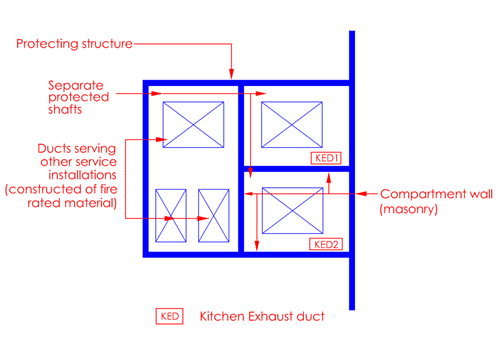
Figure 3.8.9a. - 1
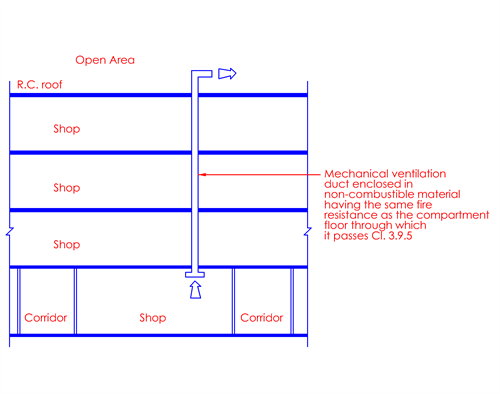
Section
Figure 3.8.9a. - 2
Kitchen exhaust duct shall be in a separate compartment from that for a mechanical ventilation duct. Kitchen exhaust ducts serving different kitchens shall be in separate shafts. Mechanical ventilation duct serving the area of refuge shall be in different shaft from that serving the pump room. The main reason for separate shafts is to prevent smoke and fire spread from shaft to shaft.
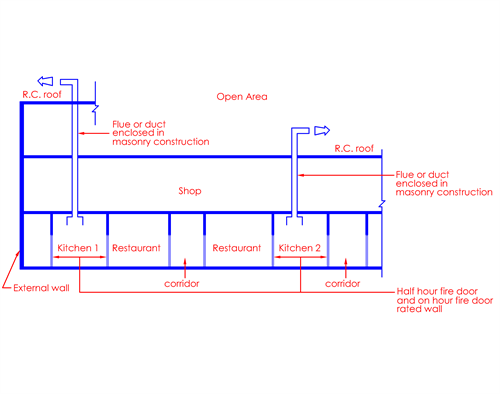
Figure 3.8.9a. - 3
a. In the above figure, the roof is not considered a floor slab, as it is exposed to the external air. Hence, the flue or duct does not pass through the floor. (See Kitchen 2)
b. When the flue or duct passes through one or more floors (any floor), it shall be encased in masonry material to ensure stability and prevent mechanical damage. (See Kitchen 1)
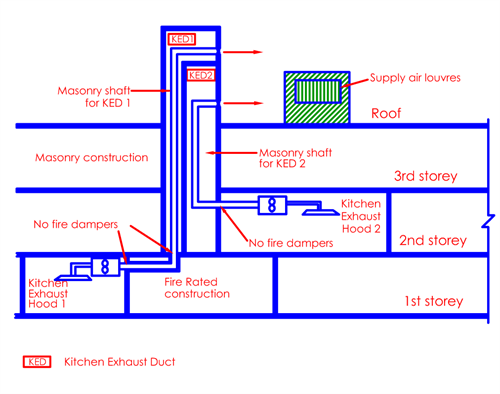
Figure 3.8.9a. - 4
Kitchen exhaust shaft for each kitchen is completely separated. The horizontal run of the exhaust from kitchen 1 is protected with fire-rated material.
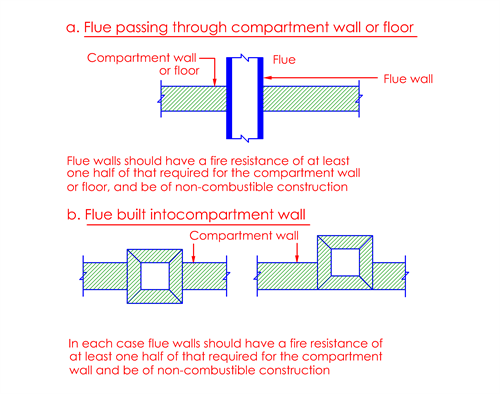
Figure 3.8.9a. - 5
If a flue, or duct containing flues or appliance ventilation duct(s), passes through a compartment wall or compartment floor, or is built into a compartment wall, each wall of the flue or duct should have a fire resistance of at least half that of the wall or floor in order to prevent the by-passing of the compartmentation.
b. Cavity barriers
A protected shaft used for the enclosure of electrical power services shall be interrupted at every floor level with at least ½-hr fire resistance cavity barriers. Protected shaft used for the enclosure of telecommunications services shall be interrupted by at least ½-hr fire resistance cavity barriers at vertical intervals not exceeding 15m. The cavity barriers within trunking enclosing electrical and telecommunication cables can be exempted if the following conditions are met:
R
Rationale - Clause 3.8.9b
Owing to the difficulty in fire-stopping the gaps within the trunking running through multiple floor levels within a protected shaft, this requirement was exempted provided additional fire safety requirements are complied with. These requirements include the use of flame retardant cables to reduce the possibility of fire from occurring/spreading, sloping of the floor within the shaft upwards at an angle of at least 45° to prevent illegal storage of any combustible materials, and the provision of self-closing devices to the fire resisting doors to ensure that the doors are closed at all times to prevent fire from spreading.
E
Explanations & Illustrations
Clause 3.8.9b. : Protected shaft containing
other services/installations
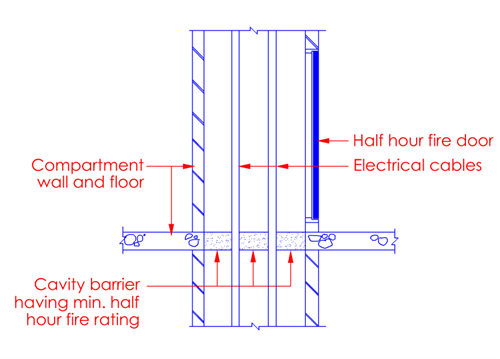
Section
Figure 3.8.9b. - 1
Protected shaft containing electrical cables shall be interrupted at every floor with cavity barrier having min. ½-hr fire rating to prevent vertical spread of fire and smoke. The main concern is that cables are a source of fuel and ignition. The presence of fire stopping at every floor would help to confine fire to a single storey or segment of the shaft.
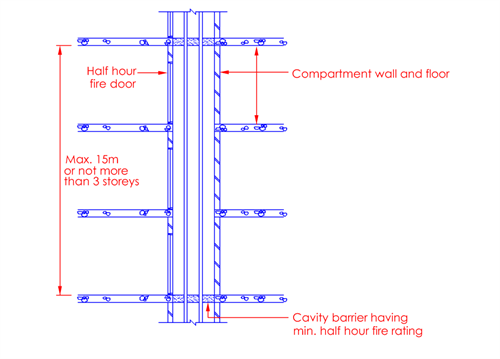
Section
Figure 3.8.9b. - 2
Protected shaft containing telecommunications cables including cable TV lines is provided with cavity barrier at vertical intervals not exceeding 15m or 3 storeys whichever is the shorter. The cables are mainly of low voltage and hence of a lower risk when compared to electrical cables.
(1) the cables shall be flame retardant type complying with IEC 60332;
(2) the floor within the shaft shall be sloped upward with an angle of at least 45° to the floor level; and
(3) the fire doors to the protected shaft are installed with self-closing devices.
c. Self-closing devices
Automatic self-closing devices are not required to be installed on fire resisting doors opening into protected shafts which are interrupted by at least ½-hr fire resistance cavity barriers at every floor level, or protected shafts containing sanitary pipes or water pipes, provided that the fire resisting doors are kept closed and locked at all times.
E
Explanations & Illustrations
Clause 3.8.9c. : Protected shaft containing
other services/installations
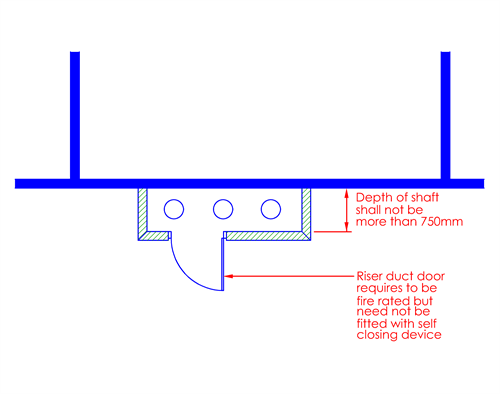
Figure 3.8.9c.
Provision of self-closing device for the inspection door of a protected shaft, which is interrupted by barriers having ½-hr fire resistance at every floor, is not required. The above relaxation is also applicable to telecommunication cable shafts, provided they are interrupted by barriers with fire resistance of at least ½ hour at every floor level.
An important point to note is the depth of the shaft which shall not exceed 750mm. If it exceeds 750mm, the shaft would be considered as a room and provision of self-closing device for the fire door becomes a necessity. The above relaxation is based on the understanding that it is unlikely that a shaft would be converted to a store if its depth is less than 750mm and that the door would normally be kept in the locked position when workmen are not carrying out servicing work. Also, maintaining the door in locked position is the responsibility of the management corporation of the estate.
d. Siting of protected shafts
All protected shafts containing services shall not be located within an exit staircase except for the case of residential apartment/ maisonette development under PG II not exceeding 4-storey where smoke-free lobby is not required
E
Explanations & Illustrations
Clause 3.8.9d. : Protected shaft containing
other services/installations
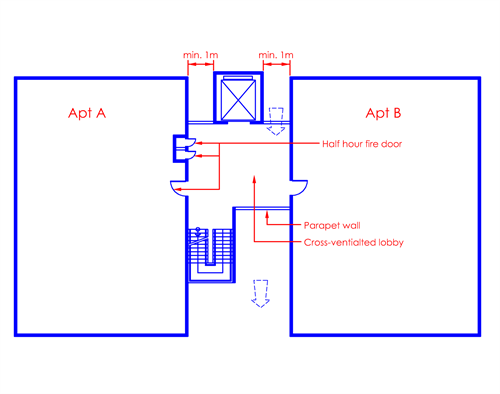
Figure 3.8.9d. - 1
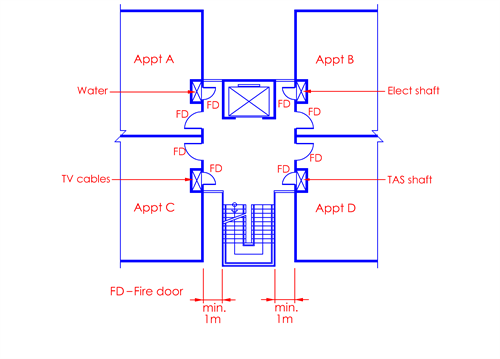
Figure 3.8.9d. - 2
Protected shafts such as for lift, TAS/Elect/Water/Cables are permitted to be located within a protected shaft containing an exit staircase for buildings under PG II, provided:
a. that building does not exceed 4 storeys where provision of smoke-stop lobby is not a requirement; and
b. that no shaft shall contain pipes carrying gas or combustible liquids. The above exception is only applicable to low-rise buildings where provision of smoke-stop lobby is not a requirement and that the staircase would be naturally ventilated. However, where there is availability of common area, such services shall be located outside the staircase shaft, see Figure 3.8.9d. – 2.
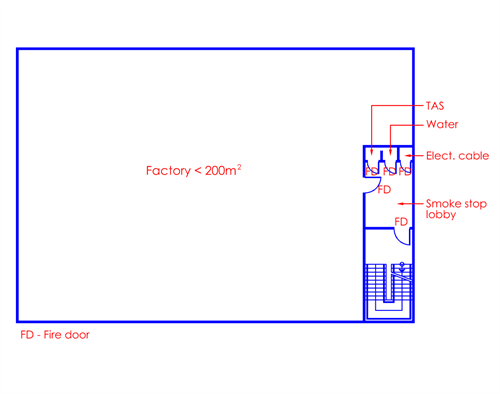
Figure 3.8.9d. - 3
A factory or warehouse building which does not require the provision of smoke-stop lobby to exit staircase by virtue of its height shall be required to comply fully with the above requirement. All protected shafts containing services are located in a common lobby adjoining the exit staircase.
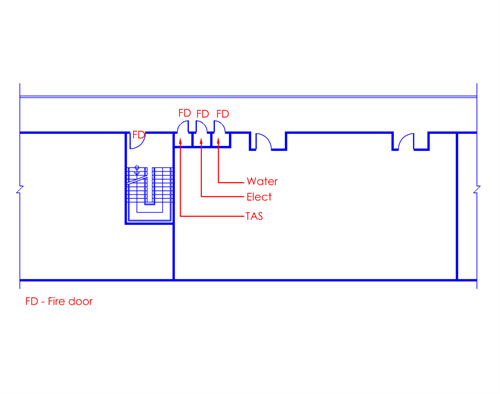
Figure 3.8.9d. - 4
Although the services are enclosed in protected shafts, they are not permitted to be located in exit staircase. The main reasons are:
a. Within the protected shaft, the combustible materials e.g. Cables PVC pipes are source of fire risk. A fire could originate from these combustible materials and spread into the exit staircase enclosure.
b. Exit staircase is a dedicated route for escape of occupants, services which are not serving the staircase shall not be located inside the enclosure.
 ) or https:// as an added precaution. Share sensitive
information only on official, secure websites.
) or https:// as an added precaution. Share sensitive
information only on official, secure websites.




.tmb-firecode.png?Culture=en&sfvrsn=716aba9e_1)
-1.tmb-firecode.png?Culture=en&sfvrsn=9551f78_1)
-2.tmb-firecode.png?Culture=en&sfvrsn=18cde179_1)






























